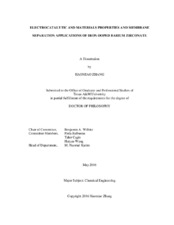| dc.contributor.advisor | Wilhite, Benjamin A. | |
| dc.creator | Zhang, Haomiao | |
| dc.date.accessioned | 2016-07-08T15:09:05Z | |
| dc.date.available | 2018-05-01T05:49:09Z | |
| dc.date.created | 2016-05 | |
| dc.date.issued | 2016-02-24 | |
| dc.date.submitted | May 2016 | |
| dc.identifier.uri | https://hdl.handle.net/1969.1/156870 | |
| dc.description.abstract | This dissertation presents the first investigation of a novel mixed conducting BaZr0.9Fe0.1O3-δ perovskite (BZF10) in terms of materials properties, combined electrochemical and catalytic properties over a complete span of gas environments (O2, CO2, H2O, CO, H2) as well as membrane separation applications. This unique combination of electrical conduction, catalytic activity and long-term material stability makes this material a promising candidate for solid oxide electrolytic cell (SOEC) and solid oxide reversible fuel cell (SORFC) applications.
Powder of BZF10 was synthesized via solid-state reaction and characterized using synchrotron X-ray diffraction (XRD); results indicated the presence of a primary cubic perovskite phase. Transmission electron microscopy (TEM) images indicated stable grain structure and well-defined grain boundaries within the pellet. Electrical conductivity relaxation (ECR) was carried out on the sintered pellet at 600-800°C under various oxygen partial pressures (pO2). ECR indicated that both chemical diffusion coefficient DV and surface kinetic parameter k’ increased with pO2. The oxygen permeation flux through BZF10 membrane at 900°C was 0.102 mL/(min·cm^2) with air/Ar gradient. Electrochemical Impedance Spectroscopy (EIS) and effluent gasses analysis were carried out at 600-800°C under a wide range of gas environments. Under dry O2 conditions, this material displayed p-type semi-conduction behavior; upon exposure to dry CO2 atmosphere, the material showed catalytic activity towards CO2 reduction to CO and O2; exposure to moisture inert suggested only mild interaction with steam; under moist CO environment, a complex conduction mechanism was displayed alongside significant rates of water-gas-shift reaction; exposure to humidified H2 resulted in increase in conductivity with H2 partial pressure indicating n-type semi-conduction. Upon completion of >1,000 hours of continuous exposures, physical inspection of the BZF10 electrochemical cell indicated negligible chemical or mechanical degradation. XRD and TEM indicated stable phase composition and stable grain structure within the pellet. The hydrogen permeation flux was 0.75 mL/(min·cm^2) at 900°C when exposed to 20%H2/Ar and controlled by bulk diffusion. In the range of 600-700°C, the hydrogen permeation was limited by the electronic transport with higher activation energy (Ea); while in the range 700-900°C, the hydrogen permeation was limited by the mixed protonic-electronic transport with low Ea. | en |
| dc.format.mimetype | application/pdf | |
| dc.language.iso | en | |
| dc.subject | Ba0.90Zr0.90Fe0.10O3−δ (BZF10) | en |
| dc.subject | Electroceramics | en |
| dc.subject | Materials Synthesis | en |
| dc.subject | Electrical Conductivity Relaxation | en |
| dc.subject | Electrochemical Impedance Spectroscopy | en |
| dc.subject | Reaction Analysis | en |
| dc.subject | Gas Separation | en |
| dc.title | Electrocatalytic and Materials Properties and Membrane Separation Applications of Iron-Doped Barium Zirconate | en |
| dc.type | Thesis | en |
| thesis.degree.department | Chemical Engineering | en |
| thesis.degree.discipline | Chemical Engineering | en |
| thesis.degree.grantor | Texas A & M University | en |
| thesis.degree.name | Doctor of Philosophy | en |
| thesis.degree.level | Doctoral | en |
| dc.contributor.committeeMember | Balbuena, Perla | |
| dc.contributor.committeeMember | Cagin, Tahir | |
| dc.contributor.committeeMember | Wang, Haiyan | |
| dc.type.material | text | en |
| dc.date.updated | 2016-07-08T15:09:05Z | |
| local.embargo.terms | 2018-05-01 | |
| local.etdauthor.orcid | 0000-0001-7933-3155 | |


